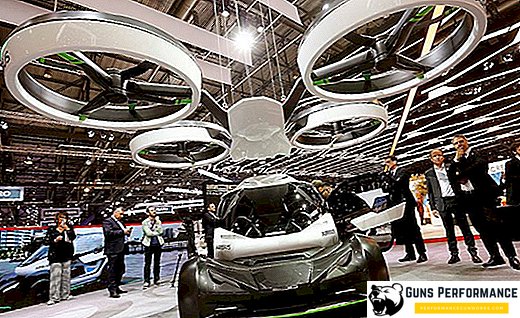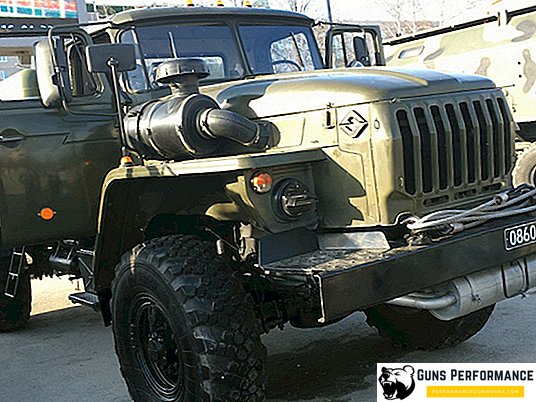At the auto show, which is now taking place in Geneva, the concept of a flying machine Pop.Up System is presented. The development of the project involved the company Airbus and ItalDesign. Larry Page and Uber are also involved in designing flying vehicles.

New history of flying cars
The authoritative Times publication in 2010 included this kind of car in the list of failed ideas of futurists. However, the trends of recent years suggest the opposite - soon people will be able to feel the atmosphere of adventures of Corben Dallas and inventor Emmett Brown.
Over the past year there has been a lot of information that large companies are engaged in the creation of conceptual versions of such equipment. We are not talking about plans for the distant future, but for the coming years. Proof of this was the development of Airbus and the Italian design agency, which creates designs of cars for many large automakers.
In the work of the car involved artificial intelligence. He calculates the best route and chooses the method of movement - by land or by air. Appearance resembles unmanned quadcopter.
What do we have today?
Despite the uniqueness of the development, American companies are ready to compete with Airbus. In early 2018, Mark Moore came to Uber, who worked as an engineer at NASA for 30 years. In 2010, Moore published the technical documentation of the machine, which has the function of vertical takeoff and landing. Mark Moore runs the Uber Elevate project (air taxi).
In 2018, there was information about the involvement of Larry Page (head of Google) to investing in startups Zee.Aero and Kitty Hawk. In these, the company employs over 150 people, they develop flying machines. Bloomberg said that Page invested more than $ 100 million in them. Zee.Aero is currently testing the first samples around California. Works are conducted in a research center owned by NASA.
The Dubai authorities have ambitious plans: in 2018, they plan to launch the first line of self-driving flying taxis. The production of devices for Dubai is engaged in the Chinese company Ehang. This project has received close attention from all over the world. The future legislation of the flying transport depends on the success of the idea.
The legislative basis for such a technique was laid in 2013 in the USA. The authorities have recognized the Terrafugia Transition folding-wing auto as a light sport aircraft. Based on this framework, laws will be created in the future. At the end of 2018, US authorities allowed to conduct practical tests of the Terrafugia Transition. Transport should appear on the market in 2019.
What is a flying car?
The technique combines the functions of the aircraft and the machine. The ratio of functions may be different. This means that one species - flies more, but drives less, and the second - drives more, but flies less.
The main condition is compact dimensions and the ability to take off outside the airfield. This definition allows the car to maintain the basic qualities - it can be near the owner anywhere, and is able to take off right from the threshold of the house. In 2008, the category of such equipment consisted of several dozen prototypes.
History of flying cars
The first examples of such developments date back to the 19th century. From that time began the gradual development of futuristic transport.
Ariel, 1841

Engineers William Henson and John Stringfellow assembled the first flying car, which is most similar to modern developments, in 1841. Practical tests failed, after which potential investors refused to invest in the project. A few years later it was closed.
Curtis avtoplan, 1917

In 1917, the public at the Pan American Aviation Exhibition saw the hybrid of an airplane and a car. The body is made of aluminum alloy. For the review, plastic windows were installed, for comfort - heating equipment in the cabin. The first tests failed, and refinement was impossible because of the start of the First World War.
Pitcairn RSA-2

The first successful prototype, similar in design to modern developments. Pitcairn PCA-2 was very famous in the first years after assembly. With him created a commercial in which the device made a successful landing in the courtyard of the White House.
Waterman Air Car, 1937

At the heart of the airmobile lay Studebaker six-cylinder engine, developing power to 100 horsepower. Waterman improved it to perform the flight function. Despite the success of the development, it did not come to mass production. Engineers collected five copies, after which the project was closed.
ConVairCar Model 118, 1947

In 1947, the prototype successfully conducted a test flight in California airspace. The main drawback is a small amount of fuel. Gasoline ran out while landing, as a result of which it was in emergency mode. The car made an unsuccessful landing, because of what the project was covered.
Ford Levacar, 1959

The development of a flying car company was engaged in Ford. The first presentation took place at an exhibition in Michigan. Designers promised consumers that the maximum speed will be 800 kilometers per hour. After several years of work on the car, Ford Levacar remained in the status of the conceptual version.
Aircar, 1966

In the 60s, experts gave perspective assessments of the development of the development. When driving on an asphalt road, the maximum speed was 120 km / h, while flying - 200 km / h. Aircraft made history as the basis for the main character of the cartoon "Planes", which released Disney.
AVE Mizar, 1973

The engineers at AVE Mizar combined the Ford Pinto car and the Cessna Skymaster. For movement in different modes, both automobile and aircraft power units were used. In the course of the first practical test, an accident occurred with a fatal outcome. After this incident, flying cars were forgotten for a long time.
Sky Commuter, 1990

The work was supervised by a large company Boeing. For takeoff, they planned to use turbo rotors. Despite the prospects of the main idea, the concept was not brought to flight tests. Nowadays, you can see a prototype in the museums of Boeing, which has been perfectly preserved for 27 years.
M400 Sky-car

Throughout his adult life, engineer Paul Moller spent on work on this project. An interesting idea is proposed for vertical takeoff and landing. Now Paul is having problems with the SEC, which resulted in numerous fines. This is the main reason for the lack of real production, but the designer remains true to his idea.
Terrafugia, 2009

The prototype was collected in 2009, the same year the first flight tests were held, which ended in success. The manufacturing company is already taking orders from customers. The cost of the car is 196 thousand dollars. Serial release plan to launch in 2019.
AeroMobil 3.0

Of the public flying cars, this one looks best. It has an attractive design, thoughtful design and small dimensions that allow you to park in the parking lot. For takeoff and landing, a relatively flat surface of 100 meters long is required.
What can be concluded?
Just 10 years ago, the embodiment of the idea of flying cars seemed impossible. But progress does not stand still, new technologies are being created that bring humanity closer to a new era. In the next 10-20 years, perhaps, we will completely abandon land transport and transfer to flying. This will solve problems with traffic jams, but it will create new ones for organizing the safe air traffic of ordinary citizens.
The main advantage will be the ability to move on environmentally friendly fuel, which will solve the problems with air pollution. The contender is now considering solar energy, but engineers will have to come up with an interesting solution for introducing solar cells into the design of flight cars without disturbing aerodynamics and other characteristics.












